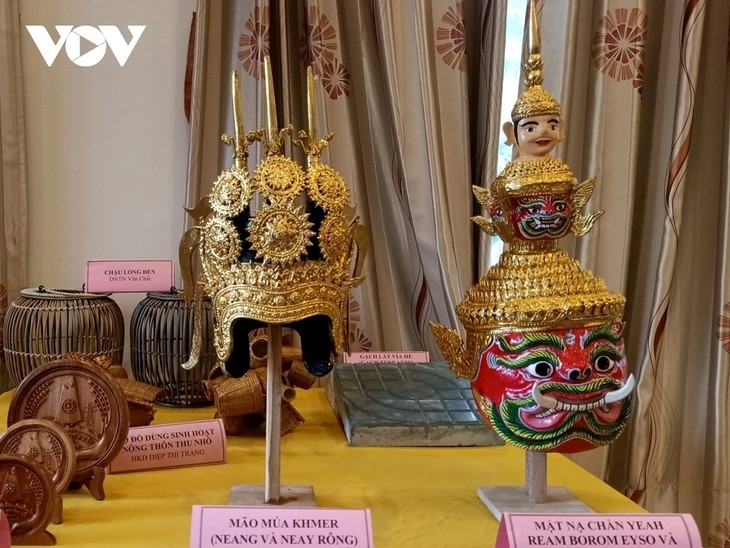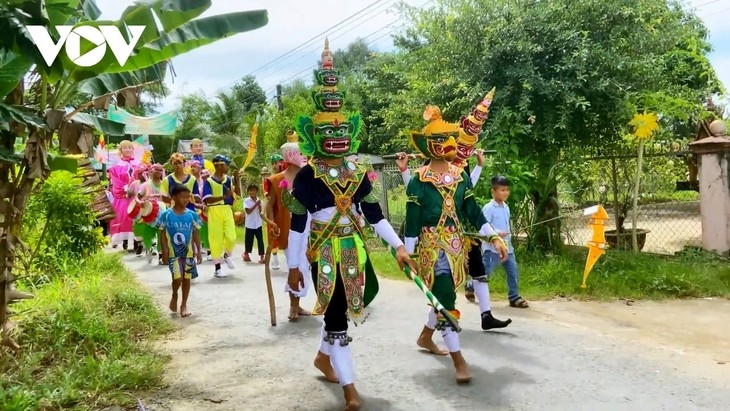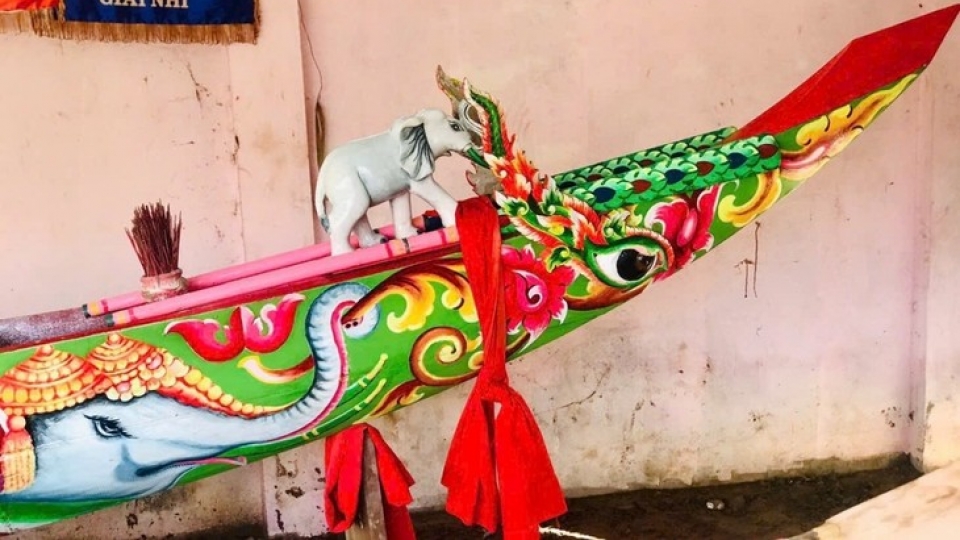Living heritage behind Khmer ceremonial hats and masks
VOV.VN - The Khmer ethnic people’s handicraft of making hats and masks for folk dancing and traditional theater performances such as Ro bam and Du ke is a distinctive cultural feature deeply connected to their spiritual life.

Each hat and mask embodies the Khmer’s soul, beliefs, and cultural identity.
The traditional craft of making hats and masks originated over two centuries ago to serve various forms of Khmer folk performing arts, including folk dances, ritual dances, and musical plays.
These products, rich in cultural and artistic value, reflect the sacred elements of the Khmer spiritual life. The shapes, colors, and patterns of each item identify the characters and dances, expressing people’s belief in triumph of good over evil and their aspiration for kindness and prosperity in life.
Crafting hats and masks is an artistic process, requiring knowledge of the arts and culture, creativity, meticulousness, and skill to produce durable and beautiful pieces.
To complete a single hat or mask, the craftsman must go through dozens of careful steps: making mold, processing material, pasting, drying, demolding, sanding, painting, drawing, embossing patterns, and decorating with sequins and beads. Each detail reflects the artisan’s devotion and craftsmanship.

In Giong Luc hamlet, Vinh Long province, once known as the “cradle” of Ro bam art, Meritorious Artisan Thach Sang tirelessly performs and crafts accessories for their performance.
“In the old days, after harvesting and before the Chol Chnam Thmay New Year celebration, those passionate about Ro bam performance gathered to set up a temporary stage and perform for the villagers. The Ro bam stages were found throughout the region, but Giong Luc hamlet was the most famous hub,” Sang shared.
At 70-years-old, Thach Sang still practices dancing every day. He creates new moves, and crafts masks for performing troupes inside and outside of the province. Sang said each drumbeat and colorful mask reminds him of the golden days of Ro bam theater.
Meritorious artisan Lam Phen from Song Loc commune, who has devoted more than 30 years to the craft, said the most challenging part of making hats and masks is expressing the character’s spirit.
“Each type of hat and mask has its own distinctive feature. For example, when making masks of the ogres Krong-Reap and Kumaka, besides following the template, we must capture their wickedness, grandeur, or kindness. Only then can the performance captivate the audience,” Phen noted.

Since 2002, artisan Lam Phen has been running a shop to showcase his products, serve visitors, and teach the craft to young people. For him, this is a source of income and a pride of this group’s tradition. In modern life, Khmer performing hats and masks have also appeared at festivals and cultural exhibitions, becoming special tourism products that attract visitors to Vinh Long.
“Crafting hats and masks requires extreme meticulousness, which sharpens the product’s artistic value and demonstrates the artisans’ dedication. Like other artistic fields, it demands both talent and perseverance. I always try to make my work as refined and effective as possible,” Dr. Son Cao Thang, Deputy Head of the Faculty of Southern Khmer Language, Culture, and Arts at Tra Vinh University said.
In June this year, the Khmer hat and mask-making craft of Vinh Long province was added to the National Intangible Cultural Heritage list. However, the number of artisans is getting fewer because the craft is mostly passed down within families.
“The craft is mainly handed down through family lines, which makes preservation difficult. To address this, we regularly organize training courses to teach the craft to people with passion, helping to sustain the profession and support cultural and artistic activities among the Khmer community,” Lam Huu Phuc, Deputy Director of the Vinh Long Department of Culture, Sports and Tourism, said.
The craft of making ceremonial hats and masks has been inseparable in Khmer traditional arts. Over time, it has become a living cultural heritage of the Khmer community.



